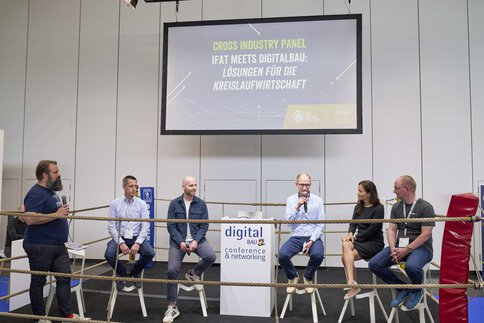Sustainable circular economy identifies potential for textile and construction industry
Environmental technology is a classic example of a crossover technology: Today, there is no industry that is not dealing with climate and environmental protection issues, as well as a sustainable circular economy and resource conservation. Modern organizational and technical solutions that meet the requirements of sustainable industries are needed. Accordingly, IFAT Munich, the world’s largest environmental technology trade fair, engages in dialog with other trade fairs on the issue of sustainable circular economies in various industries. Messe München encourages the discourse with its Cross-Industry Sessions. The new information and discussion format was first presented in June 2023 at OutDoor by ISPO and in July at the digitalBAU conference & networking event.
Still no real circular economy in the sports and outdoor industry
At the trade fair of the international outdoor industries, the discussion was about the status of recycling strategies in the sportswear market. Julia Hobohm, Doctor of Engineering and Managing Director of Gemeinsames Rücknahmesystem Servicegesellschaft mbH, a joint take-back system service company, made it clear right from the start that there is no sustainable circular economy for the sports and outdoor textile industry – certainly not on an industrial scale. “One reason for this is the variety of materials that are used in the clothing, which makes recycling extremely complex,” Hobohm told guests at the Munich Auditorium. “To bring about a change here toward sustainable industry, thought must be given right in the product development phase to what happens when the products reach the end of their life cycle, true to the ‘design for recycling’ principle,” stressed Kim Scholze, Sales Officer at functional textile manufacturer Sympatex.

Use of mono-materials supports recyclability
From Sympatex’s point of view, the use of mono-materials is a crucial step toward a sustainable circular economy. It means that the polyester membrane is combined with recycled polyester outer and lining materials, which produces homogeneous laminates that can be recycled once the products reach the end of their life cycle. Sympatex plans to completely close the textile loop for functional clothing and have 100 percent circular production by 2030.
According to Kim Scholze, further hurdles still need to be overcome together with the respective partners in order to develop an industry-wide circular infrastructure in the future. These include developing viable solutions for collecting and sorting the used textiles. One promising non-profit project, in her opinion, which should speed up the textile industry’s transition from linear to circular production, is Accelerating Circularity Europe.
Manufacturer responsibility as a potential driving force for a sustainable textile industry
“However, it is also clear that good recycling always costs money,” as Julia Hobohm emphasized at the session at OutDoor by ISPO, adding: “We also need manufacturer responsibility in the textile industry. Manufacturers would then assume financial responsibility for the recycling of their products. The worse the quality of the product, the more expensive the recycling. Take-back systems, as with packaging or batteries, would be conceivable as an organizational solution.”
Circularity as the key to a sustainable circular economy in the construction industry
The Cross-Industry Session at the digitalBAU conference & networking event, focusing on software and digitalization in the construction sector, deals with the issue of the circular economy in the construction industry. At first glance, the level of circularity achieved specifically with regard to mineral construction waste appears to be high: The industry has been reporting recycling rates of more than 90 percent for years in this area. However, Bruno Rudnik believes that assessing this performance depends heavily on which level it is being looked at. At the session, the Managing Director of the Munich-based consulting firm SusTech Consult, which specializes in sustainable technologies, spelled it out: “Our objective must be to recycle the resources so that they have an equivalent use as far as possible. However, most of the construction waste that is recycled today ends up being used in ‘inferior’ applications, such as road construction. In the construction sector, the substitution rate through secondary and recycled construction materials – and hence the metric for circularity – is just 10 to 15 percent.” According to the expert, the reasons for the low substitution rates are less technical in nature. Instead, they are due more to a lack of knowledge on the part of the users and inadequate legal standards, such as certification and standardization. Rudnik sees a major lever toward a sustainable circular economy in the construction industry in circular design, which contributes to construction materials not becoming waste in the first place.

Small solutions with a big impact on a sustainable circular economy
One company that helps simplify the organization of waste management at construction sites is the Hamburg-based startup Wastebox.biz. An online platform connects construction companies with cooperating waste disposal companies via an app. According to Felix Heiden, the Managing Director of Wastebox, his company is also currently focused on increasing the separate collection and recycling rates at construction sites. “Here, seemingly small solutions can have a significant impact. That already begins with measures such as having three dumpsters for separating different kinds of waste rather than just one for mixed construction waste,” as Heiden explained at the Munich forum, saying that Wastebox was also aiming to expand its network beyond dumpster services to include sorting, processing, and recycling plants.
Driving forces for a more intensive circular economy in the construction industry
Partnerships are also a key factor for Manuel Götzendörfer for more sustainability in the construction sector. “The circular economy will not succeed if every company attempts to develop its own solution,” as the Managing Director of BEFIVE by UnternehmerTUM emphasized. BEFIVE promotes innovation and digitalization in the construction, real estate, and infrastructure sector. Götzendörfer includes market pressure as one of the driving forces for a more intensive circular economy in the construction industry in the future: “Manufacturers of building materials and components, in particular, need to increasingly focus on where they source their materials. To obtain planning security, they want to close their loops.” Based on his observations, the first project developers are also advancing the issue of circularity by applying the cradle-to-cradle principle to entire, large-scale construction projects. He named the hybrid timber office building “The Cradle” in Düsseldorf, Germany, as one of the lighthouse projects in this area. The claim of this soon to be completed building is that almost all of the elements used in its construction can be recycled. To make it into a raw materials depot that can be put to optimum use, a digital “material passport” also lists all the materials and building components used, such as wooden beams, screws, or doors, together with information about their properties, where they are used, and their durability.
IFAT Munich: where sustainable circular economy meets bioeconomy
Bruno Rudnik, who has supervised the “Startup Area” at the environmental technology trade fair for several years now, made an explicit reference to IFAT Munich 2024. He said that there were plans to organize a “Circular Economy & Bioeconomy” topic session there on the “Green Stage”. The bioeconomy is a concept that focuses on biological resources and processes instead of fossil resources, and is geared to natural material cycles. “There is a great deal of overlap with a sustainable circular economy here – especially with regard to improved resource efficiency, a smaller carbon footprint, and recycling waste streams,” as Rudnik explained, adding: “For some time now – specifically in the Startup Area at IFAT Munich – we have seen an increasing number of young companies offering new solutions for a circular bioeconomy through innovative technologies. That includes, for example, biotechnology processes for waste recycling and wastewater treatment. There is currently also a dynamic startup landscape for biomass carbonization, for example, through pyrolysis.” He said that the bioeconomy could also play a significant role in the construction sector through the use of timber instead of steel and concrete, insulation materials based on natural fibers, or bio-based materials in construction chemistry.
